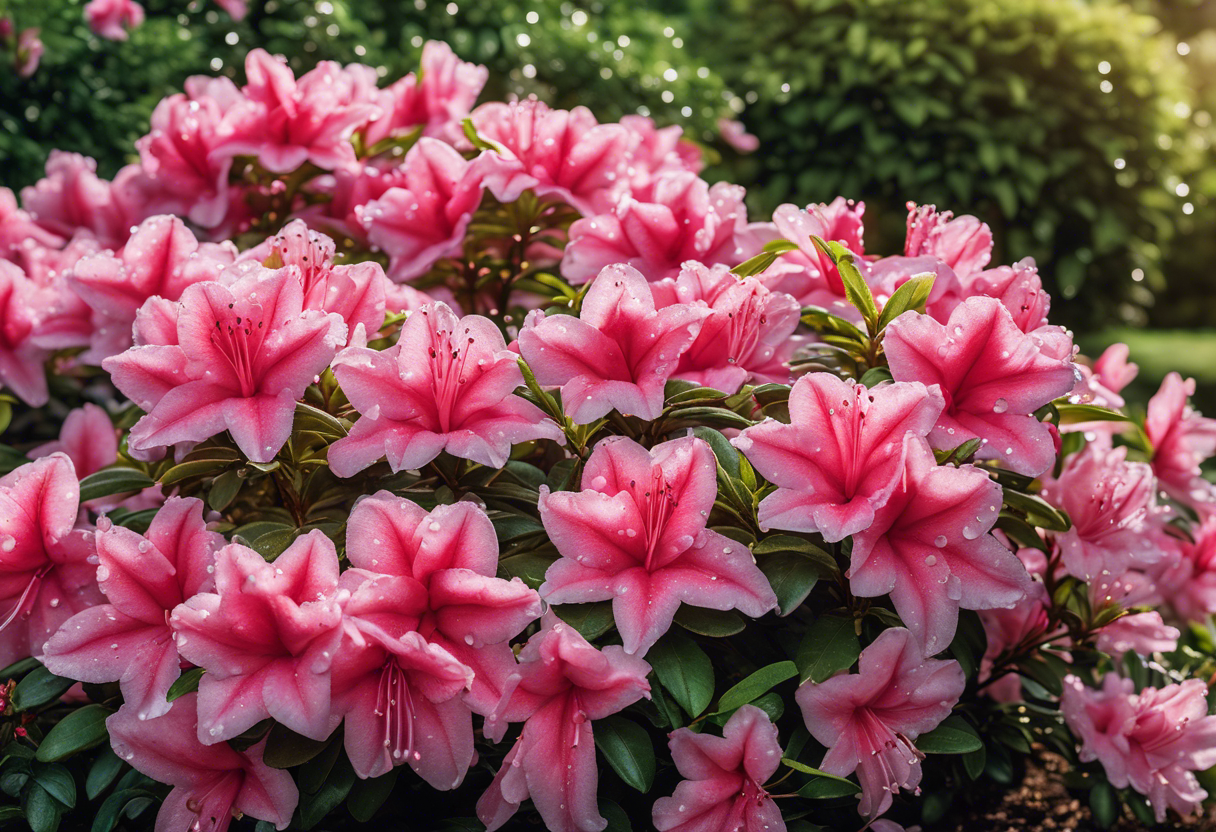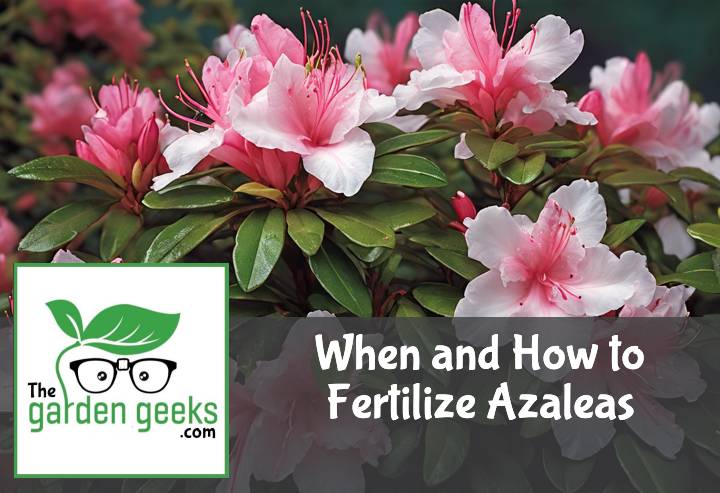Ever heard the saying, “you are what you eat?” Well, it turns out, the same applies to our leafy pals! Take Azaleas for example. These vibrant beauties can be a bit finicky when it comes to their diet. That’s where learning how to properly Fertilize Azaleas comes into play.
But don’t sweat it! We’re not talking rocket science here. Just a dash of knowledge sprinkled with a pinch of practice and voila – you’ll have blooming Azaleas that’d make your neighbors green with envy! So buckle up and keep reading about When and How to Fertilize Azaleas (For Best Results).
Key Takeaways
- Azaleas should be fertilized in late spring or early summer, after blooming.
- Use a slow-release, granular fertilizer specifically designed for acid-loving plants like azaleas.
- Apply the fertilizer around the drip line of the plant, not directly on the trunk.
- Water thoroughly after fertilizing to help absorption and prevent root burn.
- Avoid over-fertilizing as it can cause foliage burn and inhibit blooming. Regular soil testing can help maintain proper nutrient levels.

Understanding Azaleas
Azaleas, with their vibrant colors and lush foliage, are a gardener’s dream. They’re not just pretty faces though; these plants have some unique characteristics that make them stand out in the plant world. But to keep them at their best, you need to fertilize azaleas properly.
What are Azaleas?
Azaleas are flowering shrubs known for their stunning array of colors. From fiery reds to soft pinks and even snowy whites, they can light up any garden. These beauties typically grow in areas with mild climates and well-drained soil.
Their leaves range from small and narrow to large and broad, depending on the species. And when it comes to size, azaleas can be quite versatile too! Some stay compact while others can reach towering heights.
Why do Azaleas need Fertilizer?
Now, onto the nitty-gritty: why fertilize azaleas? Well, like all living things, azaleas need nutrients to thrive. Sure, they get some from the soil but sometimes it’s just not enough.
Fertilizer acts like a multivitamin for your plants. It provides essential nutrients that boost growth and enhance flower production. Without it, your azalea might start looking a bit under the weather – think fewer flowers and duller leaves.
So if you want your azalea to be the belle of the ball (or garden), don’t skimp on the fertilizer!
When to Fertilize Azaleas

Timing is everything, especially when it comes to azalea care. You see, knowing the best time to fertilize azaleas can make a world of difference in their health and blooming potential. It’s like the old saying goes, “timing is everything,” and that couldn’t be truer for our leafy friends.
Identifying the Right Time of Year
So, when exactly is the optimal time for some azalea TLC? Well, it depends on your regional climate and azalea care routine. Typically, the best season for azalea fertilizer application is during their growth cycle – usually in spring or early summer. But remember folks, every garden has its own microclimate so always keep an eye on your plants!
Signs Your Azalea Needs Fertilization
Now let’s talk signs. If you notice a change in your azaleas’ leaf color or slowed growth, it might be time to whip out that fertilizer! These are common signs of under-fertilized azaleas. Remember, they’re not just being dramatic – these changes are their way of telling you they need a nutrient boost! So next time you see those leaves turning yellowish or growth slowing down, you know what to do – fertilize azaleas!

Choosing the Right Fertilizer for Azaleas
When it comes to fertilize azaleas, you can’t just grab any old bag of plant food. It’s like cooking a gourmet meal – you need the right ingredients! Understanding what azalea nutrients your plants crave is key.
Understanding Nutrient Requirements of Azaleas
Azaleas are pretty picky eaters, let me tell ya. They have specific azalea nutrient needs that differ from other plants. You see, these beauties thrive on a diet rich in certain nutrients.
They’re big fans of nitrogen, phosphorus, and potassium – the NPK trio. But they also love their micronutrients like iron and magnesium. Don’t skimp on these if you want your azaleas blooming like a firework display!
But remember folks, too much of anything is bad news bears. Overfeeding can lead to azalea plant health issues like leaf burn or even root damage. So, balance is key when feeding azaleas.
Types of Fertilizers Suitable for Azaleas
Alrighty then, let’s talk about the types of grub your azaleas will love. There are several options available when choosing the best fertilizer for azaleas.
First up, we’ve got organic fertilizers. These bad boys are great if you’re all about that natural life. They slowly release nutrients into the soil, which is perfect for our azalea friends who don’t like being force-fed.
Next up are synthetic fertilizers. Now don’t turn up your nose at these just yet! They’re specially formulated to provide all those essential nutrients we talked about earlier.
Then there’s slow-release fertilizers – they’re like a buffet that keeps refilling itself! And let’s not forget liquid feed and granular fertilizer – both excellent choices depending on your azalea care routine.
So, whether you’re a fan of organic or synthetic, slow-release or quick fix, there’s a perfect fertilizer out there for your azaleas. Just remember to keep their nutrient needs in mind and you’ll be golden!
How to Apply Fertilizer to Azaleas
Azalea care is a walk in the park, but it’s the azalea fertilization that can be a bit tricky. It’s all about getting your hands dirty and giving those azaleas what they crave – nutrients!
Preparing the Soil for Fertilization
Before you even think about applying fertilizer to azaleas, you’ve got to prep that soil. Yep, we’re talking soil preparation for azaleas here. Start by testing your soil’s pH level. Azaleas love slightly acidic soil, so aim for a pH between 4.5 and 6.
Next up, improve your garden’s drainage. These plants hate waterlogged roots! Adding organic matter like compost or leaf mold can help with this.
Finally, clear away any debris from around the base of the plant. This will ensure that when you do apply fertilizer, it’ll get right down to those hungry roots.
The Process of Applying Fertilizer
Now onto the main event – applying fertilizer to azaleas. Don’t worry; it’s not rocket science! Start by sprinkling the fertilizer evenly around the base of each plant.
Be careful not to let it touch the stems or leaves though – we don’t want any burns here! Then, gently work it into the top layer of soil using a hand rake or similar tool.
And remember folks, less is more when it comes to fertilizing these beauties. Overdoing it can lead to salt buildup in the soil which is definitely not good news for your azaleas.
So there you have it – best practices in fertilizing azaleas made simple!
Caring for Fertilized Azaleas
After you fertilize azaleas, it’s not just a “set it and forget it” deal. Nope, your job ain’t done yet! You’ve got to roll up those sleeves and dive into some post-fertilization care. We’re talking watering, monitoring growth, and keeping an eye on their health. It’s all part of the azalea maintenance package!
Watering After Fertilization
So, you’ve fertilized your azaleas. Great job! But now comes the tricky part – watering. You see, watering fertilized azaleas is like walking a tightrope. Too little water and the fertilizer won’t dissolve properly. Too much and you risk washing away all that precious nutrient goodness.
The key here is maintaining moisture levels without turning your garden into a swamp. A good rule of thumb? Water deeply but infrequently. This helps the roots absorb nutrients effectively while preventing over-saturation.
Monitoring Growth and Health Post-Fertilization
Alrighty then, let’s talk about monitoring growth post-fertilization. Now this isn’t some high-tech operation requiring fancy gadgets or anything like that. It’s more about being observant and knowing what to look for.
Start by checking out the leaves – are they bright and vibrant or do they look a bit under the weather? Next, take a gander at the blooms. Are they plentiful and healthy or sparse and sad-looking? These visual cues can tell you a lot about your fertilized azalea care efforts.
Remember folks, gardening is as much an art as it is a science! So don’t stress too much if things don’t go perfectly right off the bat. Just keep observing plant growth, assessing plant health, and adjusting your care routine as needed.
Common Mistakes in Fertilizing Azaleas and How to Avoid Them
When it comes to azalea care mistakes, the most common one is misjudging how much fertilizer these beauties need. It’s a bit like Goldilocks and her porridge – not too much, not too little, but just right.
Over-fertilizing and Under-fertilizing: Finding Balance
Overdoing it with the fertilizer can lead to over-fertilizing azaleas, causing leaf burn or even plant death. On the other hand, under-doing it means your azaleas might lack essential nutrients for growth. So, what’s the solution? It’s all about finding that sweet spot of balanced azalea fertilization.
A good rule of thumb is to fertilize azaleas lightly but frequently during the growing season. This way, you’re avoiding over or under fertilization of azaleas. Remember folks, moderation is key!
Incorrect Timing: Avoiding Seasonal Pitfalls
Now let’s talk timing. When should you fertilize these vibrant plants? Well, there are some seasonal pitfalls in fertilizing azaleas that we need to avoid.
The best time to fertilize is in early spring before new growth starts. But beware! Fertilizing late in fall could stimulate new growth that won’t survive winter chills. So remember, correct timing is crucial when it comes to azalea care.
In conclusion, knowing how to properly fertilize azaleas can save you from a world of wrong azalea fertilization woes!

To Wrap Up
Just like a toddler thrives on a balanced diet, your azaleas crave the right fertilizers at the right time. We’ve walked you through when and how to Fertilize Azaleas for bloomin’ good results.
So, don’t let your azaleas become hangry plants. Get out there and feed those hungry blooms!


